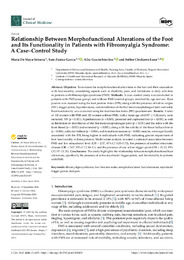Abstract:
Objective: To evaluate the morphofunctional alterations in the foot and their association with functionality, considering aspects such as disability, pain, and limitations in daily activities in patients with fibromyalgia syndrome (FMS). Methods: A case–control study was conducted in patients with FMS (case group) and without FMS (control group), matched by age and sex. Foot posture was assessed using the foot posture index (FPI), along with the presence of hallux valgus (HV), trigger points, hyperkeratosis, and dorsiflexion of the first metatarsophalangeal joint and ankle. Foot functionality was evaluated using the foot function index (FFI) questionnaire. Results: A total of 100 women with FMS and 100 women without FMS, with a mean age of 61.97 ± 9.26 years, were recruited. HV (p < 0.001), hyperkeratosis (p < 0.001), pronated and supinated foot (p < 0.001), as well as limitations in dorsiflexion of the first metatarsophalangeal joint (p < 0.001) and the ankle with the knee flexed (p < 0.001) and extended (p < 0.001), along with the activity of the flexor hallucis brevis (p = 0.006), adductor hallucis (p = 0.006), and dorsal interosseous (p = 0.002) muscles, were significantly associated with the FFI, being higher in individuals with FMS, indicating greater impairment of foot functionality in these patients. Multivariate analysis revealed a statistical association between FMS and low educational level (OR = 2.57, 95% CI 1.05–5.72), the presence of another rheumatic disease (OR = 5.07, 95% CI 2.34–11), and the presence of any active trigger point (OR = 11.15, 95% CI 3.97–31.31). Conclusions: The study highlights the relationship between morphofunctional foot alterations, specifically the presence of active myofascial trigger points, and functionality in patients with FMS.
|

.png)
